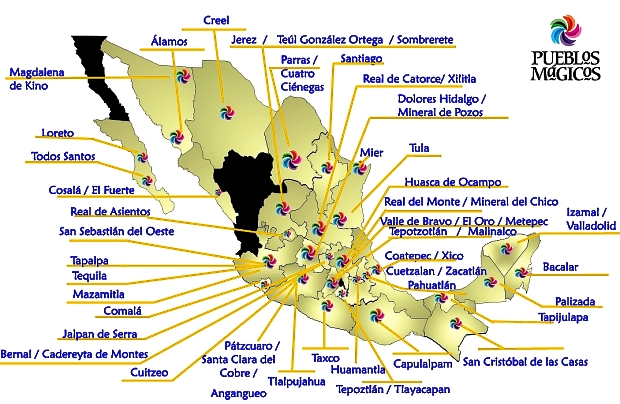It is getting just as hard to keep up with Mexico’s Magic Towns program as it is to understand why some of the places deserve to be included on the list. Since our last post about Magic Towns, three more places have been added:
#55 Loreto (Baja California Sur)
The attractive town of Loreto [ed: deservedly on the list], is built on the coast around a centuries-old mission. The town has a full range of tourist services, from expensive and ultra-luxurious to budget.
The first colonial Jesuit mission in this region was at San Bruno, 25 kilometers north of Loreto; it was founded in 1683, but lasted only two years. In February 1697, the Spanish Viceroy granted Jesuit priests Juan María de Salvatierra and Eusebio Francisco Kino permission to go to the “California Province“. This is apparently the earliest recorded mention of California as a geographic entity.
The Loreto mission, founded later that year, became extremely successful. Jesuit priests set out from Loreto to found missions throughout the Baja California Peninsula, most of them established by about 1720. Loreto was sufficiently important to function as the capital of the Californias (including the present-day U.S. state) until 1777.
#56 Valladolid (Yucatán)
Valladolid, located about half-way between Mérida and Cancún, is well worthy of Magic Town status. Founded in 1543, it is an attractive colonial city, with wide streets and considerable historical importance. The city has become increasingly popular among discerning tourists in recent years.
There are many attractions, including the numerous superb colonial buildings, such as the Cathedral in the center, and the Franciscan mission of San Bernardino de Siena, in the Sisal district of the city. The local Maya people, in traditional attire, bustle about the central square as they carry out their daily tasks. Valladolid is small enough to explore on foot, by strolling through the different districts of the city.
Coupled with excellent traditional Yucatecan cuisine, natural wonders like Cenote Zaci (a landscaped limestone sinkhole or cenote), pastel-colored walls, friendly handicraft stores, and historical murals in the government palace, what more could a visitor want?
#57 Metepec (State of México)
Metepec is a somewhat nondescript city of 160,000, located near the state capital of Toluca. The earliest Spanish settlers arrived in 1526. Metepec has numerous historic religious buildings, including the Ex-convento de San Juan and the Parish Church of San Mateo. The city’s major claim to fame in terms of handicrafts are ceramic “trees of life” and similar objects. Since 1990, the city has celebrated an annual international arts and culture festival, Quimera, every October.
This map from the Tourism Secretariat (Sectur) shows Mexico’s 57 Magic Towns (as of September 2012):
How many more Magic Towns will there be? Will the program continue after the new President takes office later this year? Watch this space!
Related posts:
- Magic or mystery? Mexico adds four more Magic Towns to its list (#51, 52, 53, 54)
- Mexico’s 50 Magic Towns (#49, 50)
- Mexico’s Magic Towns now number 48, and counting… (#45, 46, 47, 48)
- Mexico adds three more Magic Towns to its list (#42, 43, 44)
- Mexico’s Magic Towns program to continue at least until 2012
- Mexico’s Magic Towns now include Zacatlán in the Sierra Norte of Puebla

Sorry, the comment form is closed at this time.